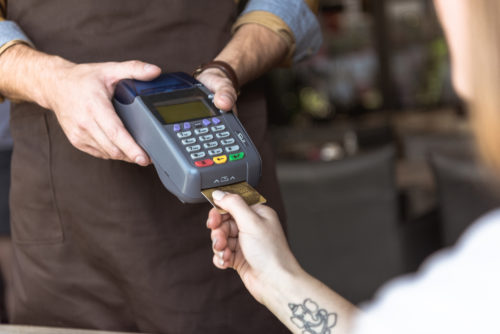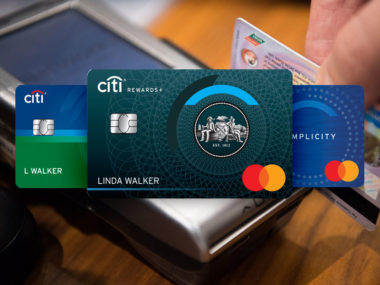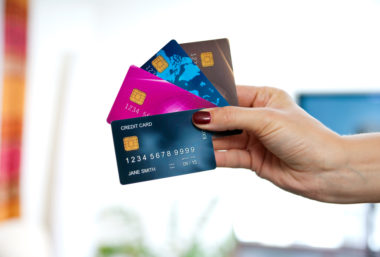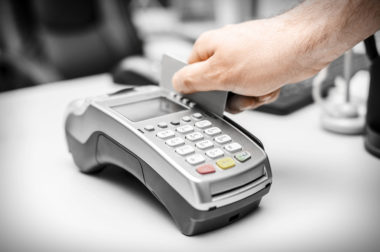In the United States, debit cards were traditionally protected by personal identification number (PIN) codes, while credit cards just required signatures. It was always fairly simple, and when you went to purchase anything from groceries to a new shirt, you knew what to expect based on which card you used.
However, things started to change when banks began rolling out debit and credit cards with EMV chips. EMV — which stands for Eurocard, Mastercard, and Visa — is a new type of authentication that was first introduced in Europe and Canada. Almost all travel you do outside of the United States will require the use of an EMV chip, as most foreign credit card readers no longer use the magnetic strip on the back of cards.
But EMV chips aren’t the only changes coming to American credit cards from across the pond and the Great White North. Now, instead of only having signature verification for credit cards, some credit card companies are also requiring PIN verification — but this change has yet to become universal with all card issuers.
What are chip-and-pin credit cards, and what does this change mean for card holders in the U.S.A.? Will you be seeing a PIN credit card soon, or are some issuers not yet onboard with this new change? Let’s dive in and find out.
Table of Contents
What Are Chip and PIN Credit Cards?
Here are some important terms to keep in mind while you read through this piece:
- Issuer: your bank or lender which distributes your money or your credit
- Network: the organization that processes the transaction, securely connecting the point of sale check-out system with the issuing bank to allow payments to be verified and approved. In the US networks are primarily Visa, Mastercard, American Express (Amex), and Discover
- Merchant: the business in which you are making a purchase, or the entity accepting credit card payments
All of these aspects of a credit card (or debit card) transaction will have an influence on how your card is processed and what verification methods are used in order to ensure you are the owner of the card you are using.
When you look at a typical credit card, you have a series of numbers, an expiration date, your name, and the card issuer as well as the network provider on the front. On the back is the magnetic strip, a line for your signature, and the card verification value (CVV) which is normally three or five numbers (with the except of Amex, which has the CVV on the front of the card).
How have credit cards changed with the new chips and PIN verification?
What Are EMV Chips?
Now, with the new chip cards, there is also a square on the front of the card that looks like something that belongs inside a computer. This is your embedded EMV microchip.
EMVs are computerized chips that helps track when a card is used, as well as scramble the code used to make the purchase, which can help prevent identity theft — specifically, the sort of theft that can happen if a merchant’s purchasing system has experienced a data breach.
Both debit and credit cards can have EMV chips, and this is a form of reading the card in addition to the magnetic strip. The merchant and their system’s card reader will determine if the EMV or magnetic strip are used to complete the purchase.
PIN Priority vs Signature
However, only some U.S. EMV chipped credit cards will also have PIN verification, and these are known as chip-and-PIN cards. The issuer and network are in charge of deciding the forms of verification used, and you will be asked to create a PIN (if it is required) when you first receive and activate the card.
On the reverse, some credit cards will still only require a signature with purchases and will not require you to set up a PIN or may not even give you the option to create one, and these are called chip-and-signature cards. When making a purchase with a merchant, a receipt will print out asking for your signature, or the electronic card reader may offer an electronic signature on its touch pad. Unfortunately, if you are traveling abroad and are using your card with a merchant that only allows PIN verification, you may not be able to complete the transaction using your chip-and-signature card, as there will not be a way to verify your identity.
Some card issuers offer both signature and PIN verification, but depending on the preference of the issuer, it may default to either of the two options. So when you’re making a purchase, if you have a signature-preferred or signature-priority card, it will default to a signature. The opposite will happen for PIN-preferred or PIN-priority cards.
Where Are Chips and PIN Cards Used?
Chip cards and PIN verification can be used in the States, but it is often rare to come across PIN verification for a credit card transaction here. It may happen if you use your credit card at an ATM and request a cash-advance (if your card allows it), but other than that, PIN-priority verification is dependent on the issuer’s preference.
However, chip-and-PIN cards are widely used across Europe, in Canada, and in some other foreign countries around the world. If you travel to Europe, chances are you will need a chip-and-PIN card in order to make purchases, unless you only bring cash with you. It’s best to check with your issuer before you travel to see if PIN verification is something you can set up on your credit card.
Can You Get Chip and PIN Credit Cards in USA?
Yes, chip-and-pin cards are available in the states, and it’s only within the past couple of years that credit card issuers in the U.S.A. have started to ask for a PIN form of verification. However, the decision to use a PIN for verification, or PIN-priority, is typically made by the issuer of the card. Some issuers allow the customer to decide which verification method is preferred (such as the State Department Federal Credit Union).
Additionally, even if you have a signature-priority card, your issuer may still request that you set up a PIN verification for when a signature is not an option, such as when traveling internationally.
Typically, issuers that are more widely accepted around the world — or those that have cards that are specifically made for international travel — will have chip-and-PIN cards available for customers. Some common examples of issuers that offer chip-and-PIN cards include:
- Bank of America
- Barclays bank
- Citibank
- Navy Federal Credit Union
- State Department Federal Credit Union
- USAA
- Wells Fargo
Some of the most common issuers that do not include PIN verification for their credit cards include:
- American Express (Amex)
- Capital One
- Chase bank (despite having multiple travel-based cards, they do not offer PIN verification on any of their cards, yet)
- Discover
- U.S. Bank
Chip and PIN Alternatives
When traveling internationally, it’s always best to do your homework before you leave for your vacation or business trip. It’s also recommended (and sometimes required) to notify your card issuer of your travel plans (without notifying them, they may shut off your card out of fear that a fraudulent transaction has taken place). If by calling your issuer you find your card doesn’t offer PIN verification, and you’re unable to get a second credit card, then what should you do?
Luckily, most larger cities throughout Europe are accustomed to the needs of American tourists, and will ask you for a signature on a receipt slip if your card requires it. Even with PIN-priority being the norm in Europe, most merchants are able to accommodate signature requests from issuers.
However, some unattended kiosks in train stations or subways may not have a signature option, and may ask you for a PIN verification even if you don’t have one for your credit card. If this happens, you may have to go to an ATM, withdraw cash with your debit card, and use the kiosk by paying in cash instead.
Because of this inconvenience, you may want to save your cash for unattended kiosks, and use your card when you’re purchasing from merchants in the city. Overall, the majority of transactions will not have an issue when traveling overseas, and only the more rural areas or unattended kiosks will have potential issues with chip-and-signature cards.
Image Source: https://depositphotos.com/





